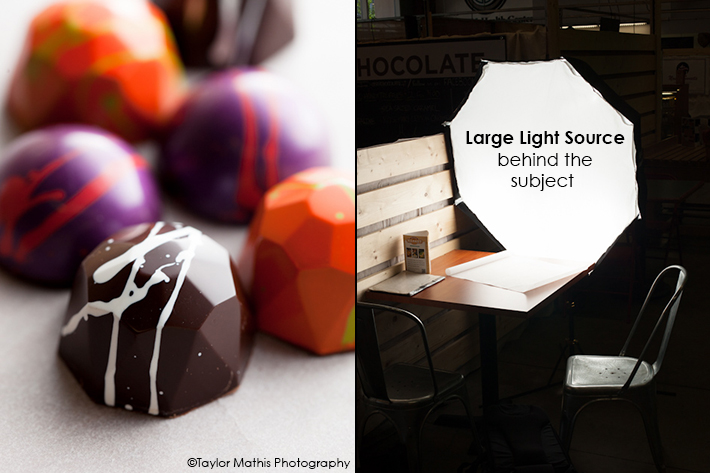What do you do when you find yourself in a restaurant without a decent window to shoot by? You will have to create your own light. If you are new to food photography and never had to use artificial light to light a dish, you may find yourself unsure of where to start. You don't need multiple flashes and a bunch of modifiers to create a beautiful shot. All you need is a flash, a light stand, a large diffusion source, and a piece of white foam board. Here is how I use these tools to create a beautiful backlit shot.

Above is the set-up. The large light source is placed on one side of the table. Set up your camera on the opposite side with the dish in between. The key to a back lit shot is having the the light behind your subject. You can use any large soft box that you like. Pictured is the Westcott 43" Apollo Orb , but you can use your favorite large soft box like lighting modifier. You could use a shoot through umbrella, but the light may not be diffused enough and may spill too much on the background. Here are the results using a back lit approach.

Backlighting is a great look for food. It creates nice highlights on liquids and sauces, can illuminate steam and using the large light source creates a nice soft light that falls over the dish. In a dark restaurant, it can create a light and bright scene. To avoid having the light source in your shot and introducing lens flare, shoot at a high enough angle so that the table top or plate will be the background.
Here are a few more examples of this set up in action.


Notice how the light's position creates nice highlights on the egg yolk.
Most restaurant table tops will have a reflective quality to them. Using a large diffused light source behind your subject will give the table a nice even highlight. If this highlight falls off in your image, you can move your camera or light source until the whole table is lit. Next time you find yourself stuck with lighting your dish, give back lighting a try!
For more food lighting and styling tips take a look at Issues 1-7 of photographing FOOD!







It was a great tutorial but man do you guys do Food Lighting posts A LOT..
Once a week isn't nearly enough.
Literally. 9 posts on food photography in the last 2 months. Hint, backlight everything!
Lighting is where people struggle the most so it seams to me that Taylor is doing a great job of really covering it. I cannot tell you how often I hear, "Man, I hate working with flash. I am terrible at it."
I have to try this. I have all the lights, just never used them like this before.
This is actually a very, very good tip.
Love the food photography tips! Really appreciate all the free information!
Good stuff!
What focal length do you recommend? What f stop are you ususally shooting with?
Great now I know what to bring to my next lunch at the local restaurant ;)
kool. I love simple lighting. I have this setup, gonna try it. Thanks.
To the people complaining about the scope of this article:
Get a grip! its free! Go make your own dumb blog, stop shitting on this one.
Great post
Can you please tell us more about the focal length used in these shots, and the f stop,
Thanks!!
Assuming that you don't have a natural light try improvise lighting for instance: Background -vast white foam board, white bed sheet or table cloth or white card board and Bounce or reflector – an alternate bit of white foam board, or card board wrapped in aluminum foil to achieved the desired lighting in food photography whenever you are in a restaurant without a decent window lighting to shoot by.
<a href="http://www.jeremymerriam.com/" rel="nofollow">JeremyMerriam.com</a>
What kind reflector?
I am very new to photography and don't know much a about strobes, modifiers and reflectors. I see in the picture that you are using a square reflector? Where can I get one of those ones?
Only a few months into photography.
Just received a medium size softbox, and white and silver reflectors so this article is perfect for me.
Am writing a slightly different kind of cook book, tip tricks and substitutes, but gotta have great looking photos!
Have been using natural light until now. Not bad but very flat.
Attached is just a random one of about 40 different images.
Need to go back and shoot many of them - and recook them!
Photos in book will only be about 7.5 x 7.5"
The later cropping concerns me.